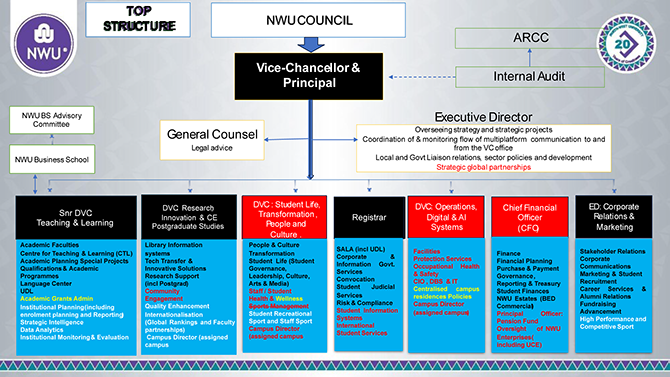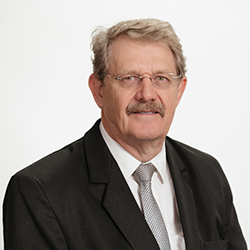
Greetings everyone
The NWU Council held an extraordinary meeting on 11 December 2024, to consider the University Management's structure realignment proposal. In the Council newsletter of September 2024, we informed stakeholders that the NWU Top Structure that management presented was approved, and that the next phase, Phase 3B-1, had commenced. Phase 3B-1 involved a review of the management levels within the divisions and faculties. During the Phase 3B-1 process, management identified opportunities for further integration and enhancement of the Top Structure and revised the structure as follows:
Click on the image below to enlarge.

In a nutshell, the following changes have been made.
- The DVC: Institutional Planning and Internationalisation has been abolished and its functions or duties reassigned to both the Senior DVC: Teaching and Learning and DVC: Research, Innovation and Community Engagement.
- Campus management functions have been assigned as follows:
- the DVC: Operations, Digital and AI Systems: Potchefstroom Campus
- the DVC: Student Life, Transformation, People and Culture: Mahikeng Campus; and
- the DVC: Research, Innovation, and Community Engagement: Vanderbijlpark Campus.
- High-performance and competitive sports moved to Corporate Relations and Marketing. This move aims to position NWU Sport as a strategic organisational value proposition for both staff and students. Recreational and Staff Sport remain within DVC: Student Life, Transformation, People and Culture portfolio.
Phase 3B-1
Regarding the Phase 3B-1 structure realignment, management established a Project Management Office (PMO) and enlisted the services of Deloitte Consulting to review the cascading levels below the Top Structure. That is, positions below the UMC levels up to Peromnes 5 in faculties and up to Peromnes 6 in support divisions. The process involved engagements with members of the Senior Management Committee, chief directors, and relevant directors. These engagements resulted in several iterations of the structures guided by the following principles:
- Assessment and Analysis: Comprehensive evaluation of roles, reporting relationships, and decision-making processes
- Development of Overarching Principles: Frameworks for optimisation at faculty and division levels, ensuring alignment with NWU's strategic priorities
- Facilitation of Dialogue: Internal consultations facilitated by Deloitte, with stewardship from internal PMO team, relevant SMC members, chief directors, and relevant directors, incorporating stakeholder perspectives into structural realignment decisions; and
- Strategic Design: Alignment of structural recommendations with the NWU's guiding principles for operational excellence, strategic impact and growth.
Council approved the proposed structures for the faculties and divisions and requested management to continue identifying opportunities for further integration and enhancement. The same principle and approach that created operational efficiencies during the Top Structure alignment must be applied during Phase 3B-2. Council will consider any proposal aimed at ensuring overall efficiency and effectiveness.
Implementation of the Student Information System (SIS) and Phase 3B-2
Council noted the urgency to finalise the relevant structures that will be affected by the implementation of the Student Information System (SIS). Therefore, Council approved the expedited implementation of Phase 3B-2 within the Registrar's environment to align with SIS project requirements.
The SIS implementation is a cornerstone of the NWU's digital transformation strategy, and its success is essential for:
- improving student and staff experiences through efficient and user-friendly systems
- enhancing the NWU's ability to manage and leverage data for decision-making and strategic planning; and
- solidifying the NWU's competitive position in higher education by adopting innovative and future-ready systems.
The SIS is expected to go live in January 2025.
Management will prioritise communication with staff regarding the approved structures that are affected by the SIS implementation.
Council noted that Phase 3B-2 in other areas will commence early in January 2025 and conclude by March 2025. It is envisaged that the official implementation of newly approved structures will be 1 June 2025.
It is emphasised that the realignment project aims to support the efficient and effective implementation of the NWU strategy - Taking the NWU Forward: 2024 and beyond. As indicated in the vice-chancellor's communiques, the realignment aims at shaping a fit-for-purpose structure that aligns with the strategic direction of the university. The realignment also focuses on maintaining the NWU's unitary model while enhancing accountability and clarity in our leadership framework.
Of particular importance is the assurance provided consistently in the vice-chancellor's communiques that no job losses will occur at any level during the realignment process, while emphasising the need for the repurposing of certain positions and redeployment that will take place across the portfolios.
The changing landscape of the higher education sector in South Africa and beyond dictates that we position the NWU to be more efficient, agile, and responsive to the needs of stakeholders while we ensure long-term sustainability.
I encourage all staff to work in collaboration to ensure the successful implementation of the entire realignment project.
I wish you a joyous festive season.
Happy holidays
Bert Sorgdrager
Chairperson: NWU Council
| Your feedback will be appreciated |
